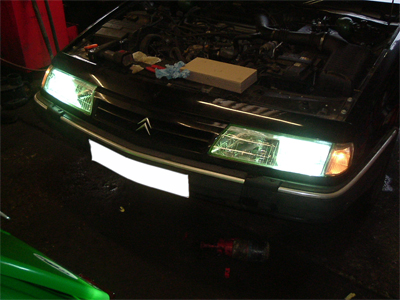|
At a recent visit to PTS
Developments in Wokingham, I mentioned the
problem and Pete Sparrow recommended fitting HID gas
discharge (Xenon) lights. These are not to be
confused with regular halogen bulbs with a blue tint;
these are the same lights that are fitted to many
top-of-the-range cars and have a light output tilted
towards the blue end of the visible light spectrum.
Among the claimed advantages of HID headlights are
higher intensity, longer life, superior colour, and
better directivity.
HID lamps are about 3 times as efficient as halogen
lamps. Thus, even when the efficiency of the DC-DC
converter is taken into consideration, the lower power
input can actually result in much brighter headlights
than are possible with halogen bulbs. This reduced
power also leads to cooler operation and less drain on
the battery and alternator.
Lifespan - an HID lamp can be expected to last 2,700
hours or more. Essentially, the HID lamp may outlast
the car.
Spectral output - the light from the HID lamp is
richer in blue (and more like daylight) than halogen
bulbs, thus enhancing reflectivity of signs and road
markings. Furthermore, clothing that contains
white flecks (undissolved washing powder) reflects Ė
as anyone who has been to a disco with UV lamps can
confirm.
Beam pattern - the small arc size of the HID lamp
permits the optical system to be optimised to direct
light more effectively to where it is needed and
prevent it from spilling over to where it is not
wanted. Couple this with the complex surface
reflectors and you have an extremely well demarcated
beam pattern.
It is necessary to equip the car with a number of
electronic components. The HID bulb itself is
similar in basic design to traditional HID lamps (a
common example being the fluorescent tube used in
interior lighting). Two electrodes are sealed in a
quartz envelope along with a mix of solids, liquids,
and gasses. When cold, these materials are in their
native state (at room temperature) but are mostly
gases when the lamp is hot. Starting of these lamps
may require up to 20 KV to strike an arc but only 50
to 150 V to maintain it. Lamps may be designed to
operate on either AC or DC current depending on
various factors including the size and shape of the
electrodes. A unique set of ballast operating
parameters must be matched to each HID bulb.
Of all the problems that had to be addressed for HID
headlights to become practical (aside from the cost),
the most significant was the warm-up time which was
solved by programming the controller to deliver
constant power to the lamp rather than the more common
nearly constant current that would be provided by a
traditional ballast. With this twist along with a
special lamp design, the lamp comes up to at least 75%
of full intensity in under 2 seconds.
As hinted earlier, this is not a cheap solution but is
money well spent; not least because the kit can be
removed and fitted to another car at minimal
cost. The standard headlights may be refitted
when it is time to sell the car.
This really is money well spent Ė especially if you
live in a rural area. My XM is utterly
transformed. Driving at night is much
easier. The diffuser was left in situ
and the beam pattern is unchanged. Judging by
the failure of oncoming drivers to flash their lights,
they cause minimal annoyance to other road
users.
Clearly, these lights can be fitted to any car but the
law
in the UK requires any such car to be fitted with
either a headlamp beam adjuster or self-levelling
suspension and headlamp washers.
|
 |